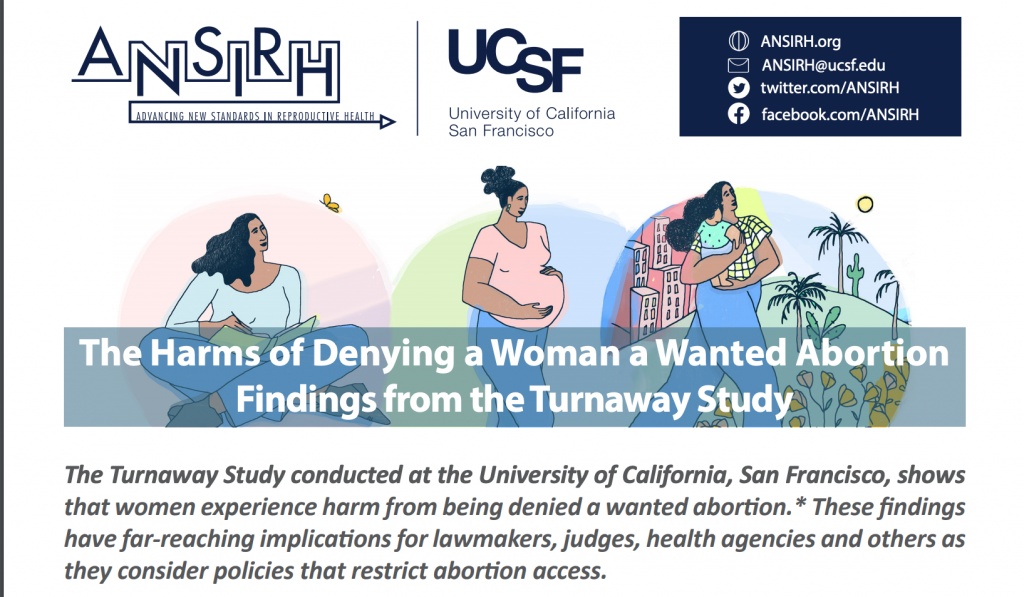What was the motivation to conduct the Turnaway Study? What questions in the public conversation around abortion did you feel needed to be answered?
We started the study in 2007, and the real point was to answer the question ‘does abortion hurt women?’ Anti-abortion campaigns use this idea that women might be harmed by having made the decision to have an abortion, and there weren’t good data to address the question. So the aim was to design a study that would actually capture the experience of women who are in the position of having a pregnancy that they didn’t want: What happens to them if they’re able to get their abortion versus they’re not able to get their abortion? And although the motivation started with ‘does abortion hurt women?’ the data we collected also opened our eyes to the answers to the question ‘does restricting access to abortion hurt women?’
What makes the study design of the Turnaway Study so rigorous? How can people, including legislators, feel confident using the findings?
Before the Turnaway Study, there was little quality research on the physical and social consequences of unintended pregnancy for women. The existing body of work often used inappropriate comparisons groups—comparing, for example, women who obtain abortions with those who continue their pregnancies to term by choice. In the Turnaway study design, the groups are the same at the beginning and so the differences in their trajectories can be attributed to whether they received or were denied an abortion.
Because abortion access is so uneven across the states, you can go to one state where the latest abortion facility goes to 18 weeks, and another where it goes only to 14 weeks, and another where it goes to 20 weeks. By going to 30 different sites in 21 different states, we were able to get people who were just over the gestational limit, and people just under the gestational limit. Because these sites had different limits, they were sometimes women at the exact same gestation, receiving abortion in one place and denied in another.
What are your top takeaways from the findings?
There is no evidence that abortion causes mental health harm. We did not find an increasing trend of depression or anxiety among people who received an abortion. In fact, being denied an abortion was associated with increased anxiety and lower self esteem in the short run. And not only that, but the vast majority of people who receive an abortion, say it was the right decision for them over the five years. The physical risk of carrying a pregnancy to term and delivering is much greater than the risk of having an abortion. It’s not just the immediate outcomes of the pregnancy that differ…the physical health risks from having been pregnant and giving birth extend for years. And women who are denied abortions are more likely to live in poverty, be raising children alone without family or partners, and to not have enough money to pay for basic living needs. So there’s a huge economic hit that comes from having a child when you weren’t ready to have a child. We also asked people what their plans were for the coming years and women who receive an abortion were more likely to set aspirational plans for the coming year than women who are denied. (Bookmark the summary of all study findings here)
How can these findings be useful in policymaking conversations, in your opinion?
This study shows that having access to abortion services affects the well-being of women, their partners, their existing children, and their future children. There are policy implications for public assistance, employment, housing, and food security. The state needs to consider the well-being of all people involved.
Another really important topic that policymakers should consider, that comes from these data, is when people discover they’re pregnant. There’s often a temptation to pass restrictions that limit access to abortion based on when in pregnancy a woman seeks an abortion. I think there’s an assumption that people are sitting around waiting to come in. And that is not accurate. We don’t find that that’s the case at all. In fact, often, the reason for delay is that people didn’t discover they were pregnant earlier. Most commonly because that they didn’t have pregnancy symptoms, they continue to have what they thought were periods or they have never had regular periods, they just had a baby, or they have a chronic health condition with the same symptoms as pregnancy- and so they didn’t realize they were pregnant.
Your book really makes the connection between the data and the real people that were part of the study. As the lead researcher on the Turnaway Study, what was it like talking with so many people across the country about their experiences accessing abortion care?
For me, the book has two goals. One is to share the science and the findings. But it isn’t an abstract scientific debate. It’s not possible to understand abortion without hearing from people who have sought abortion care. It’s very possible to pass abortion laws, and not consider the people whose lives you’re affecting. So the second goal of the book is to introduce you to the people whose lives are being affected. These aren’t people who chose to be advocates, they’re just people who were recruited into this study. |
